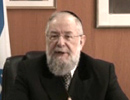Beit Midrash
- Sections
- Chemdat Yamim
- Parashat Hashavua
- Torah Portion and Tanach
- Bereshit
- Lech Lecha
Why wasn’t the covenant done with all the descendants of the righteous Shem? The answer seems to be alluded to in the story of Nimrod, found in last week’s parasha. He is described as a great warrior, who took control of much of the region of Mesopotamia (Bereishit 10: 8-10). This region is one that is populated primarily by the descendants of Shem. Chazal attributed to Nimrod the dubious distinction of the leader of the generation that built the Tower of Bavel. Thus, we can view Nimrod as rebelling against Noach’s decree that the sons of Cham will be subservient to those of Shem and Yefet, and he did so with the plan to generally rebel against Hashem.
Avraham was the only one who had the bravery to rebel against Nimrod’s leadership and publicly criticize his heretical ways. It was against that backdrop that Avraham left Ur Kasdim, as the Torah retells at the end of Parashat Noach. That is why, in Parashat Lech Lecha, Avraham is chosen to have a new covenant made with his family. Looking carefully at Bereishit 17: 1-15, one sees many of the phrases and ideas found in regard to the covenant with Noach repeated here. These include the idea of seeing, the sign of the covenant, and an eternal covenant.
However, it may be even more instructive to consider the differences between the processes of entering into the two covenants. Whereas the rainbow was found in a place where all can see, Hashem appeared to Avraham in a manner that involved only him. Instead of "all flesh" being involved, as was the case regarding Noach, this covenant is found in the flesh of "every male." Finally, the place of the sign of the covenant is the most covered part of the body.
The covenant with Avraham ushered in a new chapter in human history. Avraham was chosen to establish a holy nation, one that guards the covenant and makes the matter of physical modesty a necessary and fundamental condition for the fulfillment of the mitzva to procreate. The nation of Avraham’s descendants was charged with the obligation to teach the world about the oneness of Hashem, which takes on its full meaning when we base our lives on sanctity and purity.
On Yom Kippur, we beseeched Hashem, "Labrit habet v’al tefen layetzer" (look at the covenant and do not look at [the actions instigated by our evil] inclinations. A key to the success of our request that Hashem look at the covenant is that we keep our part in the covenant.

Those Who Argue With Prophecy
Rabbi Yossef Carmel | Sivan 29 5775

Parashat Hashavua: Neither Menashe Nor Yerachme’el
Rabbi Yossef Carmel | Tevet 5786

A Decision on a Different Plane by a Nation Fit for It
Rabbi Shaul Yisraeli zt"l | 5775






















